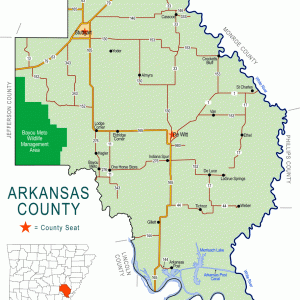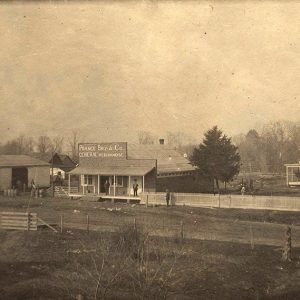calsfoundation@cals.org
Crockett’s Bluff (Arkansas County)
Crockett’s Bluff, a town in Arkansas County, is located on a bluff over the White River. It figures prominently in the history of Grand Prairie rice production, river commerce, and waterfowl hunting.
John Pate, likely a trapper or fisherman, arrived after purchasing military land grant No. 3286 on the future townsite in November 1820. The next known resident was William Finley Crockett, son of frontiersman Davy Crockett. He arrived from Tennessee around 1842 with wife Clorinda and sons David and William and established a home at that location on the White River. William F. Crockett died on January 12, 1846. In April of that year, Crockett Township was created by Arkansas County. By 1846, a post road existed between Crockett’s Bluff and Arkansas Post. The Crockett’s Bluff post office was established in March 1848 by John Smith, who had married Clorinda Crockett. Robert Hamilton Crockett, nephew of William, arrived at Crockett’s Bluff in 1856 with his wife Mary and widowed mother Martha. He gained prominence in Arkansas County as a lawyer, military leader, publisher, and politician. He moved to DeWitt (Arkansas County) in 1881 and later served as the first mayor of Stuttgart (Arkansas County).
Although he was a Unionist until his state seceded, Crockett raised a company of Confederate soldiers in 1861. Crockett’s Bluff itself did not experience as much Civil War action as nearby St. Charles (Arkansas County) did. Surveyor W. R. Lear platted the Crockett’s Bluff townsite in 1869. After the war, Crockett’s Bluff grew in importance as a center for fishing, fur trading, logging, shelling, and general White River commerce. The river bluff featured a break in the elevation locally known as the “hole in the wall,” which served as a convenient port for the ever-expanding river traffic. In 1894, a wave of immigration brought a number of German families from Nebraska and other Midwestern areas. Bethlehem Lutheran Church was established and served the new arrivals, including the families of Prange, Mewes, Stecks, Koch, Conrad, Dupslaff, Luebke, Witt, Sornborger, Pool, Steyer, and Bothe.
The advent of rice production, first accomplished on a large scale by Henry Prange in 1906, created more economic expansion. In 1909, two steam-operated pumping stations were erected—one by Chris Prange and A. A. Tindall, operators of a mercantile store, and the other by John Vos—to lift river water onto the adjacent White River Prairie, with a series of canals for irrigation purposes. This grew into a commercial enterprise providing water for area farmers. By 1920, the farm of brothers C. H., George, and August Prange was the nation’s largest rice farming operation, with 6,000 acres in production. Among businesses established at Crockett’s Bluff were the general stores of Isaiah Inman, Mamie Crump, Orley Kline, Chris and Annina Prange, Pete and Edna Prange, and Sebastian Schwab. P. J. Burger and Chris Prange operated sawmills to serve the vast expanses of timber lands. For a time, the Pranges operated the Caddo, a riverboat designed for hauling rice from Crockett’s Bluff. Rice growing became Crockett’s Bluff’s leading economic source as commerce shifted from the river to overland transportation.
Large-scale agriculture continued to bolster the town’s economy through the twentieth century and beyond. Soybean and other grain production emerged as a major share of local agriculture. The mid-century rise in popularity of waterfowl hunting brought much economic activity to the area. In the twenty-first century, Crockett’s Bluff is known for its fishing and waterfowl hunting opportunities, with several hunting lodges and private accommodations available for the periodic influx of sporting enthusiasts. The town is home to the Crockett’s Bluff Hunting Lodge, established in 1938 and listed on the National Register of Historic Places in 2008. The post office at Crockett’s Bluff is the oldest in continuous service in Arkansas County.
For additional information:
Crockett, Robert H. “Arkansas.” Ed. Shirley J. Young. Grand Prairie Historical Bulletin 41 (July 1998): 49–50.
———. “A Bogus Crockett.” Arkansas Democrat, December 23, 1882, p. 2.
Goodspeed, L. C. Biographical and Historical Memoirs of Eastern Arkansas. Chicago: Goodspeed Publishing, 1890.
Halliburton, W. H. A Topographical Description and History of Arkansas County, Arkansas from 1541 to 1875. Easley, SC: Southern Historical Press, 1978.
Henderson, J. M. “The Story of Colonel Robert H. Crockett,” Grand Prairie Historical Bulletin 5 (January 1962): 13–18.
“An Imposter Denounced.” Arkansaw Traveler (Little Rock), December 31, 1882, p. 4.
Mosenthin, Glenn, and Prange, Jim. “William Finley Crockett: Crockett’s Bluff Namesake.” Grand Prairie Historical Bulletin 62 (April 2019): 62–63.
Prange, Jim. “Bethlehem Lutheran Church, Crockett’s Bluff, Arkansas.” Grand Prairie Historical Bulletin 64 (April 2021): 10–19.
———. “Some Prange Family Memories in Crockett’s Bluff,” Grand Prairie Historical Bulletin 56 (October 2013): 2–13.
“Prange Brothers Own the Largest Rice Farm.” DeWitt (Ark.) New Era, May 13, 1920, p. 1.
H. Glenn Mosenthin
Grand Prairie Historical Society
 Arkansas County Map
Arkansas County Map  Crockett's Bluff
Crockett's Bluff 



Comments
No comments on this entry yet.